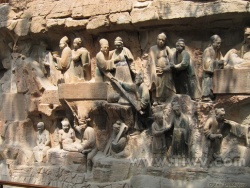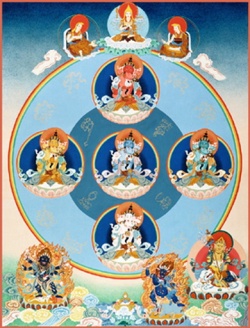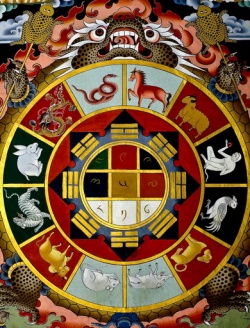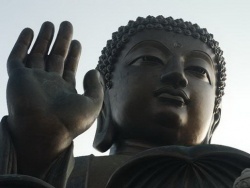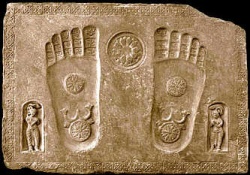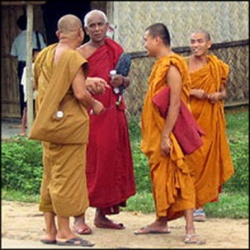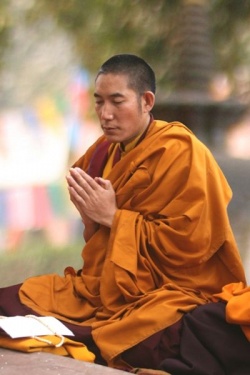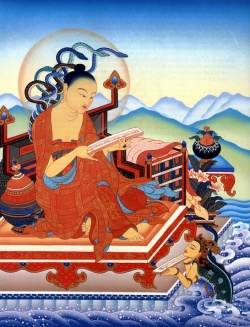Mahasiddha
Mahasiddha (Tibetan: གྲུབ་ཐོབ་ཆེན་པོ, Wylie: grub thob chen po; or Tibetan: ཏུལ་ཤུག, Wylie: tul shug; Sanskrit Devanagari: महासिद्ध; IAST: mahāsiddha, maha meaning "great" and siddha meaning "adept") is a term for someone who embodies and cultivates the "siddhi of perfection."
They are a certain type of yogin/yogini recognized in Vajrayana Buddhism. Mahasiddhas were tantric practitioners, or tantrikas who had sufficient empowerments and teachings to act as a guru or tantric master. A siddha is an individual who, through the practice of sadhana, attains the realization of siddhis, psychic and spiritual abilities and powers.
Their historical influence throughout the Indic and Himalayan region was vast and they reached mythic proportions which is codified in their songsof realization and hagiographies, or namthar, many of which have been preserved in the Tibetan Buddhist canon. The Mahasiddhas are the founders of Vajrayana traditions and lineages, such as Dzogchen and Mahamudra. [[File:Vajradhara_and_84_Mahasiddhas.jpg|thumb|250px|Vajradhara and 84 Mahasiddhas
Robert Thurman explains the symbiotic relationship between Tantric Buddhist communities and the Buddhist universities such as Nalanda which flourished at the same time:
- The Tantric communities of India in the latter half of the first Common Era millennium (and perhaps even earlier) were something like “Institutes of Advanced Studies” in relation to the great Buddhist monastic “Universities.”
They were research centers for highly cultivated, successfully graduated experts in various branches of Inner Science (adhyatmavidya), some of whom were still monastics and could move back and forth from university (vidyalaya) to “site” (patha), and many of whom had resigned vows of poverty, celibacy, and so forth, and were living in the classical Indian saiñnyãsin or sãdhu style.
I call them the "psychonauts" of the tradition, in parallel with our “astronauts,” the materialist scientist-adventurers whom we admire for their courageous explorations of the “outer space” which we consider the matrix of material reality. Inverse astronauts, the psychonauts voyaged deep into “inner space,” encountering and conquering angels and demons in the depths of their subconscious minds.
Genealogy and historical dates
The exact genealogy and historical dates of the Mahasiddhas are contentious. Dowman (1986) holds that they all lived between 750 CE - 1150 CE.
Mahasiddha tradition
Abhayadatta Sri is an Indian scholar of the 12th century who is attributed with recording the hagiographies of the eighty-four siddha in a text known as The History of the Eighty-four Mahasiddha (Sanskrit: Caturasitisiddha pravrtti; Wylie: grub thob brgyad bcu tsa bzhi'i lo rgyus).
Dowman holds that the eighty-four Mahasiddha are spiritual archetypes:
- The number eighty-four is a "whole" or "perfect" number. Thus the eighty-four siddhas can be seen as archetypes representing the thousands of exemplars and adepts of the tantric way. The siddhas were remarkable for the diversity of their family backgrounds and the dissimilarity of their social roles. They were found in every reach of the social structure: kings and ministers, priests and yogins, poets and musicians, craftsmen and farmers, housewives and whores.
The non-monastic Mahasiddha Dharma is composed of artists, business people, healers, family people, politicians, nobility, prostitutes and outcasts. The Mahasiddhas were a diverse group of people who were practical, committed, creative and engaged with their world. As a collective, their spirituality may be viewed as key and essential to their lives; simple, in concert and accord with all aspects of their lived experience.
The basic elements of the lives of the Mahasiddas included their diet, physical posture, career, relationships; indeed "ordinary" life and lived experience were held as the principal foundation and fodder for realization. As siddhas, their main emphasis in spirituality and spiritual discipline was a direct experience of the sacred and spiritual pragmatism.
Reynolds (2007) states that the mahasiddha tradition:
- ...evolved in North India in the early Medieval Period (3-13 cen. CE). Philosophically this movement was based on the insights revealed in the Mahayana Sutras and as systematized in the Madhyamaka and Chittamatrin schools of philosophy, but the methods of meditation and practice were radically different than anything seen in the monasteries.
Reynolds (2007) proffers that the mahasiddha tradition:
- ...broke with the conventions of Buddhist monastic life of the time, and abandoning the monastery they practiced in the caves, the forests, and the country villages of Northern India.
In complete contrast to the settled monastic establishment of their day, which concentrated the Buddhist intelligenzia [sic.] in a limited number of large monastic universities, they adopted the life-style of itinerant mendicants, much the wandering Sadhus of modern India.
The mahasiddha tradition may be conceived and considered as a cohesive body due to their spiritual style, sahaja; which was distinctively non-sectarian, non-elitist, non-dual, non-elaborate, non-sexist, non-institutional, unconventional, unorthodox and non-renunciate. The mahasiddha tradition arose in dialogue with the dominant religious practices and institutions of the time which often foregrounded practices and disciplines that were over-ritualized, politicized, exoticized, excluded women and whose lived meaning and application were largely inaccessible and opaque to non-monastic peoples.
[[File:Tilopa.jpg|thumb|250px|Tilopa)]
Simmer-Brown (2001: p. 127), in her exposition of the charnel ground conveys how great mahasiddhas in the Nath and Mantrayana Buddhadharma traditions such as Tilopa (988–1069) and Gorakṣa (fl. 11th – 12th century) yoked adversity to till the soil of the path and accomplish the fruit, the "ground" (Sanskrit: āśraya; Wylie: gzhi) of realization; worthy case-studies for those with spiritual proclivity:
- The charnel ground is not merely the hermitage; it can also be discovered or revealed in completely terrifying mundane environments where practitioners find themselves desperate and depressed, where conventional worldly aspirations have become devastated by grim reality. This is demonstrated in the sacred biographies of the great siddhas of the Vajrayāna tradition.
Tilopa attained realization as a grinder of sesame seeds and a procurer for a prominent prostitute. Sarvabhakṣa was an extremely obese glutton, Gorakṣa was a cowherd in remote climes, Taṅtepa was addicted to gambling, and Kumbharipa was a destitute potter. These circumstances were charnel grounds because they were despised in Indian society and the siddhas were viewed as failures, marginal and defiled.
Different Mahasiddha traditions
According to Ulrich von Schroeder Tibet has different traditions relating to the mahasiddhas. Among these traditions, two were particularly popular, namely the Abhayadatta Sri list and the so-called Vajrasana list. The number of mahasiddhas varies between eighty-four and eighty-eight, and only about thirty-six of the names occur in both lists.
In many instances more than one siddha with the same name exists, so it must be assumed that fewer than thirty siddhas of the two traditions actually relate to the same historical persons. In the days when the siddhas of the later Tibetan traditions flourished in India, i.e. between the 9th and 11th centuries, it was not uncommon for initiates to assume the names of famous adepts of the past.
Sometimes a disciple would have the same name as his guru, while still other names were based on caste or tribe. In such a context the distinction between siddhas of the same name becomes blurred. The entire process of distinguishing between siddhas with the same name of different texts and lineages is therefore to large extent guesswork.
The great variation in phonetic transcription of Indian words into Tibetan may partly be the result of various Tibetan dialects. In the process of copying the Tibetan transcriptions in later times, the spelling often became corrupted to such an extent that the recognition or reconstitution of the original names became all but impossible. Whatever the reasons might be, the Tibetan transcription of Indian names of mahasiddhas clearly becomes more and more corrupt as time passes.
Geographical sites
In local folk tradition there were held to have been a number of icons and sacred sites to the 84 Mahasiddha at Bharmour (formerly known as Brahmapura) in the Chaurasi complex. Chaurasi Temples, that is, where Chaurasi means "84".
- "It is also very significant that nowhere else, except at Bharmaur in Chamba district, may be seen the living tradition of the Eighty-four Siddhas. In the Chaurasi temple complex, near which the famous temple of goddess Lakshana (8th century A.D.) stands, there once were eighty-four small shrines, each dedicated to a Siddha."
There are a number of archaeological sacred sites requiring iconographic analysis in the Chaurasi complex in Chamba, Himachal Pradesh. Though it may be hagiographical accretion and folk lore, it is said that in the reign of Sahil Varman:
- "Soon after Sahil Varman's accession Brahmapura was visited by 84 yogis/mahasidhas, who were greatly pleased with the Raja's piety and hospitality; and as he ad no heir, they promised him ten sons and in due course ten sons were born and also a daughter named Champavati."
Caturāsiti-siddha-Pravṛtti
The Caturasiti-siddha-pravrtti (CSP), “The Lives of the Eighty-four Siddhas”, compiled by Abhayadatta Sri, a Northern Indian Sanskrit text dating from the 11th or 12th century, comes from a tradition prevalent in the ancient city-state of Campa in the modern district of Bihar. Only Tibetan translations of this Sanskrit text seem to have survived.
This text was translated into Tibetan by sMon grub Shes rab and is known as the Grub thob brgyad cu rtsa bzhi’i lo rgyus or “The Legends of the Eighty-four Siddhas”.
It has been suggested that Abhayadatta Sri is identical with the great Indian scholar Mahapandita Abhayakaragupta (late 11th–early 12th century), the compiler of the iconographic compendiums Vajravali, Nispannayogavali, and Jyotirmanjari.
The other major Tibetan tradition is based on the list contained in the Caturasiti-siddhabhyarthana (CSA) by Ratnakaragupta of Vajrasana, identical with Bodhgaya (Tib.: rDo rje gdan) located in Bihar, Northern India.
The Tibetan translation is known as Grub thob brgyad cu rtsa bzhi’i gsol ’debs by rDo rje gdan pa.
There exist several Tibetan versions of the list of mahasiddhas based on the Vajrasana text. However, these Tibetan texts differ in many cases with regard to the Tibetan transcriptions of the Indian mahasiddhas names.
The 84 Mahasiddhas
By convention there are 84 Mahasiddhas in both Hindu and Tibetan Buddhist traditions, with some overlap between the two lists. The number is congruent with the number of siddhi or occult powers held in the Indian Religions.
In Tibetan Buddhist art they are often depicted together as a matched set in works such as thangka paintings where they may be used collectively as border decorations around a central figure.
Each Mahasiddha has come to be known for certain characteristics and teachings, which facilitates their pedagogical use. One of the most beloved Mahasiddhas is Virupa, who may be taken as the patron saint of the Sakyapa sect and instituted the Lamdré (Tibetan: lam 'bras) teachings. Virupa (alternate orthographies: Birwapa/Birupa) lived in 9th century India and was known for his great attainments.
[[File:Naropa.jpg|thumb|250px|Naropa)]
Some of the methods and practices of the Mahasiddha were codified in Buddhist scriptures known as Tantras.
Traditionally the ultimate source of these methods and practices is held to be the historical Buddha Shakyamuni, but often it is a transhistorical aspect of the Buddha or deity Vajradhara or Samantabhadra who reveals the Tantra in question directly to the Mahasiddha in a vision or whilst they dream or are in a trance. This form of the deity is known as a sambhogakaya manifestation.
The sadhana of Dream Yoga as practiced in Dzogchen traditions such as the Kham, entered the Himalayan tantric tradition from the Mahasiddha, Ngagpa and Bonpo. Dream Yoga or "Milam" (T:rmi-lam; S:svapnadarśana), is one of the Six Yogas of Naropa.
Four of the 84 Mahasiddhas are women. They are:
- Manibhadra, the Perfect Wife
- Lakshmincara, The Princess of Crazy wisdom
- Mekhala, the elder of the 2 Headless Sisters
- Kanakhala, the younger of the 2 Headless Sisters
Von Schroeder (2006) states:
- Some of the most important Tibetan Buddhist monuments to have survived the Cultural Revolution between 1966 and 1976 are located at Gyantse (rGyal rtse) in Tsang province of Central Tibet.
For the study of Tibetan art, the temples of dPal ’khor chos sde, namely the dPal ’khor gTsug lag khang and dPal ’khor mchod rten, are for various reasons of great importance.
The detailed information gained from the inscriptions with regard to the sculptors and painters summoned for the work testifies to the regional distribution of workshops in 15th-century Tsang.
The sculptures and murals also document the extent to which a general consensus among the various traditions or schools had been achieved by the middle of that century. Of particular interest is the painted cycle of eighty-four mahåsiddhas, each with a name inscribed in Tibetan script.
These paintings of mahasiddhas, or “great perfected ones endowed with supernatural faculties” (Tib. Grub chen), are located in the Lamdre chapel (Lam ’bras lha khang) on the second floor of the dPal ’khor gTsug lag khang.
Bearing in mind that these murals are the most splendid extant painted Tibetan representations of mahasiddhas, one wonders why they have never been published as a whole cycle.
Several scholars have at times intended to study these paintings, but it seems that difficulties of identification were the primary obstacle to publication.
Although the life-stories of many of the eighty-four mahasiddhas still remain unidentified, the quality of the works nevertheless warrants a publication of these great murals. There seems to be some confusion about the number of mahåsiddhas painted on the walls of the Lam ’bras lha khang.
This is due to the fact that the inscription below the paintings mentions eighty siddhas, whereas actually eighty-four were originally represented. [Note: According to the Myang chos ’byung, eighty-eight siddhas are represented. G. Tucci mentions eighty-four, whereas Erberto Lo Bue assumed that only eighty siddhas were shown, as stated in the inscription. Cf. Lo Bue, E. F. and Ricca, F. 1990.
Gyantse Revisited, pp. 411–32, pls. 147–60]. Of these eighty-four siddhas painted on the walls, two are entirely destroyed (G55, G63) and another retains only the lower section; the name has survived (G56). Thus, the inscribed Tibetan names of eighty-two mahasiddhas are known. Of the original eighty-six paintings, eighty-four represent a cycle of mahåsiddhas (G1–G84).
List of the 84 Mahasiddhas
In Buddhism there are 84 Mahasiddhas (the asterisk * denotes a female):
- Acinta or Acintapa, the 'Avaricious Hermit';
- Ajogi or Ayogipa, the 'Rejected Wastrel';
- Anangapa, Ananga, or Anangavajra;
- Aryadeva (or Karnaripa), the 'Lotus-Born' or the 'One-Eyed';[[File:GK36-Karnarepa.jpg|thumb|250px|Aryadeva)]
- Babhaha, the 'Free Lover';
- Bhadrapa, the 'Snob' or the 'Exclusive Brahmin';
- Bhandepa, the 'Envious God';
- Bhiksanapa, 'Siddha Two-Teeth';
- Bhusuku, Bhusukupada or Shantideva, the 'Lazy Monk' or the 'Idle Monk';
- Camaripa, the 'Divine Cobbler';
- Campaka or Campakapada, the 'Flower King';
- Carbaripa or Carpati, 'Who Turned People to Stone' or 'the Petrifyer';
- Catrapa, the 'Lucky Beggar';
- Caurangipa, the 'Limbless One' or 'the Dismembered Stepson';
- Celukapa, the 'Revitalized Drone';
- Darikapa, the 'Slave-King of the Temple Whore';
- Dengipa, the 'Courtesan's Brahmin Slave';
- Dhahulipa, the 'Blistered Rope-Maker';
- Dharmapa, the 'Eternal Student' (c.900 CE);
- Dhilipa, the 'Epicurean Merchant';
- Dhobipa, the 'Wise Washerman';
- Dhokaripa, the 'Bowl-Bearer';
- Dombipa, the 'Tiger Rider';
- Dukhandi, the 'Scavenger';
- Ghantapa, the 'Celibate Monk' or the 'Celibate Bell-Ringer';
- Gharbari or Gharbaripa, the Contrite Scholar (Skt., pandita);
- Godhuripa, the 'Bird Catcher';
- Goraksa, Gorakhnath or Goraksha, the 'Immortal Cowherd';
- Indrabhuti, (teachings disseminated to Tilopa);
- Jalandhara, the 'Dakini's Chosen One';
- Jayananda, the 'Crow Master';
- Jogipa, the 'Siddha-Pilgrim';
- Kalapa, the 'Handsome Madman';
- Kamparipa, the 'Blacksmith';
- Kambala, the 'Yogin of the Black Blanket' (or the 'Black-Blanket-Clad Yogin');
- Kanakhala*, the younger of the two Headless Sisters or Severed-Headed Sisters;
- Kanhapa (or Krsnacarya), the 'Dark-Skinned One' (or the 'Dark Siddha');
- Kankana, the 'Siddha-King';
- Kankaripa, the 'Lovelorn Widower';
- Kantalipa, the 'Rag Picker' (or the 'Ragman-Tailor');
- Kapalapa, the 'Skull Bearer';
- Khadgapa, the 'Master Thief' (or the 'Fearless Thief');
- Kilakilapa, the 'Exiled Loud-Mouth';
- Kirapalapa (or Kilapa), the 'Repentant Conqueror';
- Kokilipa, the 'Complacent Aesthete';
- Kotalipa (or Tog tse pa, the 'Peasant Guru';
- Kucipa, the 'Goitre-Necked Yogin';[[File:Kukkuripa.jpg|thumb|250px|Kukkuripa)]
- Kukkuripa, (late 9th/10th Century), the 'Dog Lover';
- Kumbharipa, 'the Potter';
- Laksminkara*, 'The Mad Princess';
- Lilapa, the 'Royal Hedonist';
- Lucikapa, the 'Escapist';
- Luipa, teachings disseminated to Tilopa;
- Mahipa, the 'Greatest';
- Manibhadra*, the 'Model Wife' or the 'Happy Housewife';
- Medhini, the 'Tired Farmer';
- Mekhala*, the elder of the two Headless Sisters or Severed-Headed Sisters;
- Mekopa, the 'Wild-Eyed Guru' (or the 'Guru Dread-Stare');
- Minapa, the 'Fisherman';
- Nagabodhi, the 'Red-Horned Thief';
- Nagarjuna, "Philosopher and Alchemist",
- Nalinapa, the 'Self-ReliantPrince';
- Nirgunapa, the 'Enlightened Moron';
- Pacaripa, the 'Pastrycook';
- Pankajapa, the 'Lotus-Born Brahmin';
- Putalipa, the 'Mendicant Icon-Bearer';
- Rahula, the 'Rejuvenated Dotard';
- Saraha, the "Great Brahmin"
- Sakara or Saroruha;
- Samudra, the 'Pearl Diver';
- Santipa (or Ratnakarasanti), the 'Academic' (the 'Complacent Missionary') was a teacher of Brogmi;
- Sarvabhaksa, the 'Empty-Bellied Siddha' (or the 'Glutton');
- Savaripa, the 'Hunter', held to have incarnated in Drukpa Künleg;
- Syalipa, the 'Jackal Yogin';
- Tantepa, the 'Gambler';
- Tantipa or Tanti, the 'Senile Weaver';
- Thaganapa,
- Thaganapa, 'Master of the Lie' (or the 'Compulsive Liar');
- Tilopa, the "Great Renunciate"
- Udhilipa, the 'Flying Siddha' (the 'Bird-Man');
- Upanaha, the 'Bootmaker';
- Vinapa, the 'Music Lover', the 'Musician' (teachings disseminated to Indrabhuti) and Tilopa};
- Virupa, inspired the Sakya lineage;
- Vyalipa, the 'Courtesan's Alchemist'.
Names of the 84 Mahasiddhas according to the Abhayadatta Sri Tradition
According to Ulrich von Schroeder the title of the above list as the Names of the 84 Mahasiddhas is misleading because Tibet has different traditions relating to the mahasiddhas. Among these traditions, two were particularly popular, namely the Abhayadatta Sri list and the so-called Vajrasana list.
The number of mahasiddhas varies between eighty-four and eighty-eight, and only about thirty-six of the names occur in both lists. It is therefore also wrong to state that in Buddhism are 84 Mahasiddhas.
The correct title should therefore be Names of the 84 Mahasiddhas according to the Abhayadatta Sri Tradition. It should also be clearly stated that only Tibetan translations of this Sanskrit text Caturasiti-siddha-pravrtti (CSP) or The Lives of the Eighty-four Siddhas seem to have survived.
This means that many Sanskrit names of the Abhayadatta Sri tradition had to be reconstructed and perhaps not always correctly.
Identification of Mahasiddhas
According to Ulrich von Schroeder for the identification of Mahasiddhas inscribed with Tibetan names it is necessary to reconstruct the Indian names. This is a very difficult task because the Tibetans are very inconsistent with the transcription or translation of Indian personal names and therefore many different spellings do exist.
When comparing the different Tibetan texts on mahasiddhas, we can see that the transcription or translation of the names of the Indian masters into the Tibetan language was inconsistent and confused.
The most unsettling example is an illustrated Tibetan block print from Mongolia about the mahasiddhas, where the spellings in the text vary greatly from the captions of the xylographs. To quote a few examples: Kankaripa [Skt.] is named Kam ka li/Kangga la pa; Goraksa [Skt.]:
Go ra kha/Gau raksi; Tilopa [Skt.]: Ti la blo ba/Ti lla pa; Dukhandi [Skt.]: Dha khan dhi pa/Dwa kanti; Dhobipa [Skt.]: Tom bhi pa/Dhu pi ra; Dengipa (CSP 31): Deng gi pa / Tinggi pa; Dhokaripa [Skt.]: Dho ka ra / Dhe ki ri pa; Carbaripa (Carpati) [Skt.]: Tsa ba ri pa/Tsa rwa ti pa; Sakara [Skt.]: Phu rtsas ga’/Ka ra pa; Putalipa [Skt.]: Pu ta la/Bu ta li, etc.
In the same illustrated Tibetan text we find another inconsistency: the alternate use of transcription and translation. Examples are Nagarjuna [Skt.]: Na ga’i dzu na/Klu sgrub; Aryadeva (Karnaripa) [Skt.]: Ka na ri pa/’Phags pa lha; and Ghantapa [Skt.]: Ghanda pa/rDo rje dril bu pa, to name a few.
Concordance lists for the identifications of Mahasiddhas
For the identification of individual mahasiddhas the concordance lists published by Ulrich von Schroeder are useful tools for every scholar. The purpose of the concordance lists published in the appendices of his book is primarily for the reconstitution of the Indian names, regardless of whether they actually represent the same historical person or not. The index of his book contains more than 1000 different Tibetan spellings of mahasiddha names.
Other mahasiddhas
Tibetan masters of various lineages are often referred to as mahasiddhas. Among them are Marpa, the Tibetan translator who brought Buddhist texts to Tibet, and Milarepa. In Buddhist iconography, Milarepa is often represented with his right hand cupped against his ear, to listen to the needs of all beings. Another interpretation of the imagery is that the teacher is engaged in a secret yogic exercise (e.g. see Lukhang). (Note: Marpa and Milarepa are not mahasiddhas in the historical sense, meaning they are not 2 of the 84 traditional mahasiddhas. However, this says nothing about their realization.) Lawapa the progenitor of Dream Yoga sadhana was a mahasiddha.
